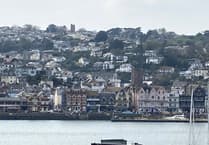Barrie has just died after an unpleasant but mercifully short illness. We will greatly miss him. He has been a first-class birdwatcher and naturalist for many years, being inspired by a visit by H.G.Hurrell to his Plymouth school over 60 years ago. He was an accomplished photographer and used this skill to record what he found; he admired the photographic work of James Ravilious.
To give some idea of the breadth of his knowledge and his great character, here are a few memories of Barrie, as recorded in our nature diary columns. Barrie was always one of the first to see something unusual, whether it was the amazingly rare Lammergeier near South Brent, in 2016, or as recorded in the nature diary in February 2002: “It’s only the early birdwatcher who catches the birds. We started our day just when Barrie Whitehall was finishing his. He had seen a Red-necked Grebe on the sea off Slapton and a Marsh Harrier sailing over the reed-beds.” Other examples are such as April 1999, “Barrie Whitehall reports a Yellow-browed Warbler is still at Slapton.” November 1999, “Barrie counted a flock of 90 Skylarks in a stubble field at East Charleton.” November 2000, “Near Start Point, Barrie found 10 Firecrests, along with Goldcrests, foraging in the bushes.” He recorded Firecrests most winters at Slapton. He also spotted many unusual insect species and events. In August 2003. “Barrie Whitehall has had a Convolvulous Hawk-moth in his garden at East Charleton. Numbers of them have been arriving from across the English Channel.” And in February 2004, “Barrie reported that he had seen three Painted Ladies at Slapton and two pairs of lizards basking in the sun.” This was the start of a massive early immigration of Painted Ladies. He spent much time with the reserve officer, Nick Binney, who has many more tales of their wildlife explorations together. This was one: “Whilst walking on the reserve at Slapton, Nick Binney and Barrie Whitehall came across a huge insect with big, goggly eyes – probably a horse-fly Tabanus sudeticus.” Geoff Foale put a photo he took of this splendid beast in his Nature Diary for June this year. Barrie would have approved! Barrie has helped with the estuary bird counts on the Kingsbridge Estuary, as well as on Slapton Ley. In the last few years he has been covering Bowcombe Creek, the site of the great swan-ringing adventure. In December 2003 he was counting at Blanksmill Creek: “Off Rowden Point, Barrie Whitehall and Peter Cummings saw several Pintail among the hundreds of Wigeon.” Numbers of Pintail have increased since then and Rowden Point area remains one of their favoured sites. In January 2003 he had witnessed a special gathering, “Early last Sunday morning Barrie was standing on the foreshore, near the mouth of Frogmore Creek. The sun had not melted the frost and sheets of thin ice covered most of the ebbing tide. Just offshore, a group of large, dark birds floated, shoulder to shoulder in an area of clear water. Barrie checked with his binoculars in disbelief. It was a flock of seven Great Northern Divers – a record for our estuary and a memory to be treasured. He watched them fishing for crabs and occasionally sitting up and exercising their wings. The great swan-ringing adventure took place in January 2000:

“ Barrie joined Dennis Elphick, Nick Ward and others help ring the Bowcombe swans. Margaret Quick threw soft brown bread down over the wall to the swans. Dennis’ team of six slowly encircled the guzzling birds. With military precision but a naturalist’s unhurried calm, Dennis organized the advance until we were within touching distance. Then five of us stretched out one arm to curl around a swan’s body, while the other hand gently held its neck. Instantaneously the three brown and white cygnets and their handsome parents were immobilized. Soft bands of cloth were wrapped over the wings, while each was weighed. Rings were put on the legs of the cygnets, so we can follow their future histories. The recording completed, all five were released at once. They waddled on their huge, webbed feet to the water’s edge and set sail, as a flotilla of graceful galleons, out onto the creek.”
Barrie Whitehall loved Slapton. He did research around the Ley, sometimes with the field centre’s staff but most often on his own. For several years he almost lived at Slapton Field Centre. But along with the serious work went a lot of fun, as on this boating expedition in December 2001:
“Bryan Ashby, Barrie Whitehall and I were pirates on the Higher Ley. Our captain was Rebecca Barrett, this year’s nature reserve officer for Slapton Ley. Rebecca was taking us out to examine patches of reed that seemed to be failing. Barrie wondered if there had been a plague of Wainscot Moth caterpillars nibbling out the heart of the reed stems. Rebecca and Barrie led the way; ‘Barrie is our pilot!’ said Rebecca. By punting and levering with the oars, Bryan and I followed Barrie and Rebecca through the head-high reeds until we reached an area where many of the stems were peppered with little holes, which Barrie thought were probably the work of weevil larvae. Some had the larger exit-holes of Wainscot Moth larvae. Several had been attacked; Barrie thought this could have been where Blue Tits or Cetti’s Warblers had removed the moth pupae. Where some reed stems had been splintered Barrie’s guess was that Water Rail might have been responsible.”Bryan Ashby and I ran an annual Family Naturalists’ course at Slapton, from 1998 to 2010 and, in most years, Barrie dropped in to help. He was excellent with the children. In August 2001, “We had the advantage this year of having Rebecca Barrett and Barrie Whitehall running moth traps, as well as having our own. Rebecca and Barrie were soon adopted by the children. Barrie also went to Start Point with us, where he showed us shearwaters flying by offshore.” In August 2005, “ Barrie Whitehall and Brenda Child joined our Family Naturalists’ course for several outings this year. Off Prawle, we saw parties of Manx Shearwaters and Barrie picked out a Balearic Shearwater with them. We were fascinated when Barrie brought in caterpillars of the Oak Eggar moth. He had used a ruse his uncle had taught him. He had hung up a female Oak Eggar he had caught in a netting cage; by lunchtime a male had arrived, attracted by her scent. He put the two together in a box and by next day, when he released them both, she had laid over a hundred eggs. Now they had hatched into tiny, wriggling Oak Eggarlets. On the last morning of our course Barrie joined us at the moth trap and identified a White-line Dart that even Barrie had never seen before. Every year Barrie joined us, he identified all the moths that no-one else could. In June 2006 he caught a Striped Hawk-moth, and in 2022 there was another invasion of this rare moth and Celia Strong caught one at Kingsbridge. Barrie gave many presentations at the research seminars at Slapton Field Centre, always illustrated by his own, excellent photos. In November 2000, “At Slapton Field Study Centre’s annual seminar Barrie showed us shocking pictures of how the water birds of the Ley had fared this year. A pea-soup algal bloom experienced in August and September dramatically reduced the availability of food. Nearly all the 30 Great Crested Grebe chicks and Mute Swan cygnets died of starvation.” He told Brenda Child how, when recording from a boat the waterbirds’ success or lack of it, he scooped up this grebe chick. He hoped it was one of those that survived. In December 2004, “At the annual Slapton Field Centre seminar, local birdwatcher and scientist, Barrie Whitehall, gave a fascinating presentation of his work mapping the territories of nesting birds around Slapton Nature Reserve. He showed how Cetti’s Warblers need scrub close to the reed-bed, how Whitethroats are almost entirely in the scrub on the backslope of the shingle-ridge by the A379 road and Blackcaps are in the scrub beneath the trees on the inland side of the ley.” Earlier that year, the nature diary recorded, “Barrie has been surveying some of the birds around Slapton Ley. He has located more than 200 Reed Warblers. Near Torcross he heard a much louder bird singing from the reeds and finally saw it, like a Reed Warbler but nearly as big as a thrush. It was a Great Reed Warbler, which usually comes no further north than France.” Barrie’s ability to recognise birds by their songs and calls was phenomenal. In May 2004, “Barrie joined me on a Common Birds Census in Andrew’s Wood. He has more acute hearing than me and would hear all the birds before I did.” His presentations were special. After one of the seminars at which Barrie gave a presentation, someone said, “I could hear every word that Barrie said and I could understand it!” An optimistic, lasting picture I have of Barrie, is of an early morning in May 2005, that he described, with eyes gleaming: “ Barrie Whitehall had a surprise while out birdwatching along Slapton Line last week. He saw a bird about Blackbird size, perched in the tree-tops beside the Higher Ley. Casually, he lifted his binoculars to check and saw black wings and bright yellow head, breast and shoulders – a beautiful, male Golden Oriole. Moments later it flew off northwards, with Barrie looking longingly after it.” This was written by Barrie in January 2021, for a nature diary article for the Kingsbridge Gazette. He was so thrilled to have this close encounter. It is typical of his enthusiasm for birds, his meticulous record-keeping and his sense of humour.

“It all began with a pellet. When I walked into the kitchen of my cottage, I noticed that there was a black object on the handrail just outside the kitchen door. I thought I knew what it might be, although I found it difficult to believe. However I was correct. It was indeed a pellet from a Barn Owl. Wow! A rather special visitor in the night had given me a gift –very fresh, black, about 30mm by 24mm and slightly sticky. It left a thin, black tarry deposit on my finger tips when I picked it up. When the pellet was broken open there were at least four lower jaw-bones of small mammals and a complete upper skull. Out came a thin paperback publication by the Mammal Society, on the analysis of owl pellets, along with a simple microscope that was either a birthday or a Christmas gift from at least 60 years ago. The skull and jaw bones proved to be those of a Wood Mouse (the first molar in the upper jaw having 4 roots and those in the lower jaw 2 roots, being highlighted in the booklet as diagnostic!). The Wood Mouse is the second most common prey item for the Barn Owl. The following evening, as I stood at the back of the cottage at 19.45, a screech from a nearby barn was followed by the sight of a ghostly, white shape emerging from the barn and flying away over a nearby orchard. The following evening at 19.55 the bird was sat on a farm gate for several minutes; it was rather blustery and it kept turning its head, presumably in response to various noises generated by the wind. It put in an appearance the following morning, before flying off west, probably to a roost site it was using. That day I was able to talk to the landowner again, having previously mentioned my sightings to him and floated the suggestion of a nest-box in the barn. I discovered he had looked at the Barn Owl Trust website and made a copy of the plans they produce for just such a box. My conversation had been at about 10.30 and at 15.00 that afternoon the front door-bell rang and I was invited out to inspect the newly completed box which had even been erected in position on the gable end inside the barn; how’s that for service?! That same evening at 19.40, I heard the owl screech in the barn, fly out and do a circuit of the adjacent field, re-enter the barn and land on top of the nest-box. I guess that most Barn Owls these days have either used a nest-box as adults or been reared in one, so are familiar with what they are and what they can be used for. A routine was now established, where the owl would turn up every evening and was also usually seen in the morning, before flying off to roost in some unknown location. A week after my first finding the pellet, I came downstairs at 06.20 to find the owl sitting on my window-ledge. It flew leisurely down to a low wall extending out from the barn, where it perched. As my eyes became accustomed to the light level I perceived a shape sitting on a farm implement just a few feet out into the field. Was it? Yes, it was – a second Barn Owl! The first bird joined this second bird and they head-bobbed and displayed to one another for several minutes, before flying off to roost.
Farmers who have erected Barn owl boxes have often had to wait many years before a bird shows an interest in their box, on this occasion there was an interest shown within hours, albeit the box had been erected where a Barn Owl had been seen. Not all boxes will get used by a breeding pair, some will just be used as a roost site, perhaps only in the winter, perhaps by the male, who can roost away from the nest site or even by the female, who may roost away from the nest site as the young grow bigger. Those boxes also play a vital role in enabling a Barn Owl to set up a territory, hence two boxes a few hundred metres apart can be even better than just one box.
The lesson from this story is that there can never be too many Barn Owl boxes, although they must be built and erected as per the guidelines laid down by the Barn Owl Trust. That however is only half the story since, as well as somewhere to nest, Barn Owls need somewhere to feed. The mammals they prey on occur at highest densities in rough grassland - so tall, tussocky grass with a layer of litter at its base. In the winter Barn Owls can range up to 5km from the nest site or roost. That tends to reduce to 2km during the nesting season. Such grass habitat can consist of isolated patches, linked by corridors like hedges and field margins. The linking up of these patches is more important for the small mammals that would want to use cover to spread out over the area. The Barn Owl will readily fly between such patches. A Barn Owl would typically need between 15 and 50ha of such habitat within its territory for it to support it and its family.
There is guidance material on the web, showing how to create and maintain a suitable grassland habitat. I would hope that in this age of increasing awareness of just how much pressure there is on our wildlife, that space can be found to enable this enigmatic bird to continue to breed amongst us. The land that is required by the bird will also be home to many other species, not perhaps as obvious or dramatic as the Barn Owl but nevertheless important to the biodiversity of the countryside.
P.S. A Christmas visit. As I prepared to eat my toast a flurry of wings outside announced the arrival of the Barn Owl, which landed on the boundary fence and sat there for 3-4 minutes. It mostly seemed to be looking directly at me. I remained as motionless as possible, as my toast went cold – a small price to pay for a memorable encounter. ”




